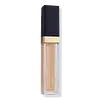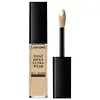Estée Lauder Futurist Soft Touch Brightening Skincealer Concealer Versus Lancôme Teint Idôle Ultra Wear All Over Concealer
What's inside
What's inside
 Key Ingredients
Key Ingredients

 Benefits
Benefits

 Concerns
Concerns

 Ingredients Side-by-side
Ingredients Side-by-side

Dimethicone
EmollientWater
Skin ConditioningMethyl Trimethicone
Skin ConditioningButylene Glycol
HumectantTrimethylsiloxysilicate
EmollientPhenyl Trimethicone
Skin ConditioningNeopentyl Glycol Diheptanoate
EmollientGlycerin
HumectantPEG-10 Dimethicone
Skin ConditioningTrametes Versicolor Extract
PEG/PPG-18/18 Dimethicone
EmulsifyingAscorbyl Glucoside
AntioxidantDisteardimonium Hectorite
StabilisingDimethicone/PEG-10/15 Crosspolymer
Sodium Hyaluronate
HumectantAcetyl Hexapeptide-8
HumectantAlgae Extract
EmollientCholesterol
EmollientHelianthus Annuus Seed Extract
Skin ConditioningTocopheryl Acetate
AntioxidantSqualane
EmollientHordeum Vulgare Extract
EmollientLaminaria Digitata Extract
Skin ProtectingCucumis Sativus Fruit Extract
EmollientHydrolyzed Yeast Protein
Skin ConditioningHydrolyzed Rice Extract
Skin ConditioningNarcissus Tazetta Bulb Extract
AstringentBHT
AntioxidantTocopherol
AntioxidantLecithin
EmollientTriethoxycaprylylsilane
Disodium Stearoyl Glutamate
CleansingAluminum Dimyristate
Emulsion StabilisingLauryl PEG-9 Polydimethylsiloxyethyl Dimethicone
Skin ConditioningPropylene Carbonate
SolventSodium Chloride
MaskingSodium Hydroxide
BufferingSodium Citrate
BufferingCaprylyl Glycol
EmollientPotassium Sorbate
PreservativeCitric Acid
BufferingSodium Benzoate
MaskingDisodium EDTA
Dipropylene Glycol
HumectantChlorphenesin
AntimicrobialPhenoxyethanol
PreservativeLaureth-7
EmulsifyingCI 77891
Cosmetic ColorantCI 77491
Cosmetic ColorantCI 77492
Cosmetic ColorantCI 77499
Cosmetic ColorantMica
Cosmetic ColorantDimethicone, Water, Methyl Trimethicone, Butylene Glycol, Trimethylsiloxysilicate, Phenyl Trimethicone, Neopentyl Glycol Diheptanoate, Glycerin, PEG-10 Dimethicone, Trametes Versicolor Extract, PEG/PPG-18/18 Dimethicone, Ascorbyl Glucoside, Disteardimonium Hectorite, Dimethicone/PEG-10/15 Crosspolymer, Sodium Hyaluronate, Acetyl Hexapeptide-8, Algae Extract, Cholesterol, Helianthus Annuus Seed Extract, Tocopheryl Acetate, Squalane, Hordeum Vulgare Extract, Laminaria Digitata Extract, Cucumis Sativus Fruit Extract, Hydrolyzed Yeast Protein, Hydrolyzed Rice Extract, Narcissus Tazetta Bulb Extract, BHT, Tocopherol, Lecithin, Triethoxycaprylylsilane, Disodium Stearoyl Glutamate, Aluminum Dimyristate, Lauryl PEG-9 Polydimethylsiloxyethyl Dimethicone, Propylene Carbonate, Sodium Chloride, Sodium Hydroxide, Sodium Citrate, Caprylyl Glycol, Potassium Sorbate, Citric Acid, Sodium Benzoate, Disodium EDTA, Dipropylene Glycol, Chlorphenesin, Phenoxyethanol, Laureth-7, CI 77891, CI 77491, CI 77492, CI 77499, Mica
Water
Skin ConditioningUndecane
EmollientDimethicone
EmollientGlycerin
HumectantTridecane
PerfumingPolyglyceryl-4 Isostearate
EmulsifyingPentylene Glycol
Skin ConditioningCetyl PEG/PPG-10/1 Dimethicone
EmulsifyingHexyl Laurate
EmollientMagnesium Sulfate
Disteardimonium Hectorite
StabilisingRosa Gallica Flower Extract
AstringentHelianthus Annuus Seed Oil
EmollientMoringa Oleifera Seed Extract
Skin ConditioningNymphaea Alba Flower Extract
Skin ConditioningIsobutane
Sorbitol
HumectantTrihydroxystearin
Skin ConditioningCellulose Gum
Emulsion StabilisingAluminum Hydroxide
EmollientDisodium Phosphate
BufferingDisodium Stearoyl Glutamate
CleansingPropanediol
SolventPropylene Glycol
HumectantCitric Acid
BufferingAcetylated Glycol Stearate
EmollientEthylhexylglycerin
Skin ConditioningAcrylonitrile/Methyl Methacrylate/Vinylidene Chloride Copolymer
Tocopherol
AntioxidantPentaerythrityl Tetra-Di-T-Butyl Hydroxyhydrocinnamate
AntioxidantPhenoxyethanol
PreservativeWater, Undecane, Dimethicone, Glycerin, Tridecane, Polyglyceryl-4 Isostearate, Pentylene Glycol, Cetyl PEG/PPG-10/1 Dimethicone, Hexyl Laurate, Magnesium Sulfate, Disteardimonium Hectorite, Rosa Gallica Flower Extract, Helianthus Annuus Seed Oil, Moringa Oleifera Seed Extract, Nymphaea Alba Flower Extract, Isobutane, Sorbitol, Trihydroxystearin, Cellulose Gum, Aluminum Hydroxide, Disodium Phosphate, Disodium Stearoyl Glutamate, Propanediol, Propylene Glycol, Citric Acid, Acetylated Glycol Stearate, Ethylhexylglycerin, Acrylonitrile/Methyl Methacrylate/Vinylidene Chloride Copolymer, Tocopherol, Pentaerythrityl Tetra-Di-T-Butyl Hydroxyhydrocinnamate, Phenoxyethanol
 Reviews
Reviews

Ingredients Explained
These ingredients are found in both products.
Ingredients higher up in an ingredient list are typically present in a larger amount.
Citric Acid is an alpha hydroxy acid (AHA) naturally found in citrus fruits like oranges, lemons, and limes.
Like other AHAs, citric acid can exfoliate skin by breaking down the bonds that hold dead skin cells together. This helps reveal smoother and brighter skin underneath.
However, this exfoliating effect only happens at high concentrations (20%) which can be hard to find in cosmetic products.
Due to this, citric acid is usually included in small amounts as a pH adjuster. This helps keep products slightly more acidic and compatible with skin's natural pH.
In skincare formulas, citric acid can:
While it can provide some skin benefits, research shows lactic acid and glycolic acid are generally more effective and less irritating exfoliants.
Most citric acid used in skincare today is made by fermenting sugars (usually from molasses). This synthetic version is identical to the natural citrus form but easier to stabilize and use in formulations.
Read more about some other popular AHA's here:
Learn more about Citric AcidDimethicone is a type of synthetic silicone created from natural materials such as quartz.
What it does:
Dimethicone comes in different viscosities:
Depending on the viscosity, dimethicone has different properties.
Ingredients lists don't always show which type is used, so we recommend reaching out to the brand if you have questions about the viscosity.
This ingredient is unlikely to cause irritation because it does not get absorbed into skin. However, people with silicone allergies should be careful about using this ingredient.
Note: Dimethicone may contribute to pilling. This is because it is not oil or water soluble, so pilling may occur when layered with products. When mixed with heavy oils in a formula, the outcome is also quite greasy.
Learn more about DimethiconeDSG is used as a surfactant.
Surfactants are cleansing ingredients that help remove oil, dirt, and other impurities from the skin. They work by reducing surface tension between water and oils/dirt to allow them to be easily rinsed away.
Disteardimonium Hectorite comes from the clay mineral named hectorite. It is used to add thickness to a product.
It can also help stabilize a product by helping to disperse other ingredients.
Hectorite is a rare, white clay mineral.
Learn more about Disteardimonium HectoriteGlycerin is already naturally found in your skin. It helps moisturize and protect your skin.
A study from 2016 found glycerin to be more effective as a humectant than AHAs and hyaluronic acid.
As a humectant, it helps the skin stay hydrated by pulling moisture to your skin. The low molecular weight of glycerin allows it to pull moisture into the deeper layers of your skin.
Hydrated skin improves your skin barrier; Your skin barrier helps protect against irritants and bacteria.
Glycerin has also been found to have antimicrobial and antiviral properties. Due to these properties, glycerin is often used in wound and burn treatments.
In cosmetics, glycerin is usually derived from plants such as soybean or palm. However, it can also be sourced from animals, such as tallow or animal fat.
This ingredient is organic, colorless, odorless, and non-toxic.
Glycerin is the name for this ingredient in American English. British English uses Glycerol/Glycerine.
Learn more about GlycerinPhenoxyethanol is a preservative that has germicide, antimicrobial, and aromatic properties. Studies show that phenoxyethanol can prevent microbial growth. By itself, it has a scent that is similar to that of a rose.
It's often used in formulations along with Caprylyl Glycol to preserve the shelf life of products.
Tocopherol (also known as Vitamin E) is a common antioxidant used to help protect the skin from free-radicals and strengthen the skin barrier. It's also fat soluble - this means our skin is great at absorbing it.
Vitamin E also helps keep your natural skin lipids healthy. Your lipid skin barrier naturally consists of lipids, ceramides, and fatty acids. Vitamin E offers extra protection for your skin’s lipid barrier, keeping your skin healthy and nourished.
Another benefit is a bit of UV protection. Vitamin E helps reduce the damage caused by UVB rays. (It should not replace your sunscreen). Combining it with Vitamin C can decrease sunburned cells and hyperpigmentation after UV exposure.
You might have noticed Vitamin E + C often paired together. This is because it is great at stabilizing Vitamin C. Using the two together helps increase the effectiveness of both ingredients.
There are often claims that Vitamin E can reduce/prevent scarring, but these claims haven't been confirmed by scientific research.
Learn more about TocopherolWater. It's the most common cosmetic ingredient of all. You'll usually see it at the top of ingredient lists, meaning that it makes up the largest part of the product.
So why is it so popular? Water most often acts as a solvent - this means that it helps dissolve other ingredients into the formulation.
You'll also recognize water as that liquid we all need to stay alive. If you see this, drink a glass of water. Stay hydrated!
Learn more about Water